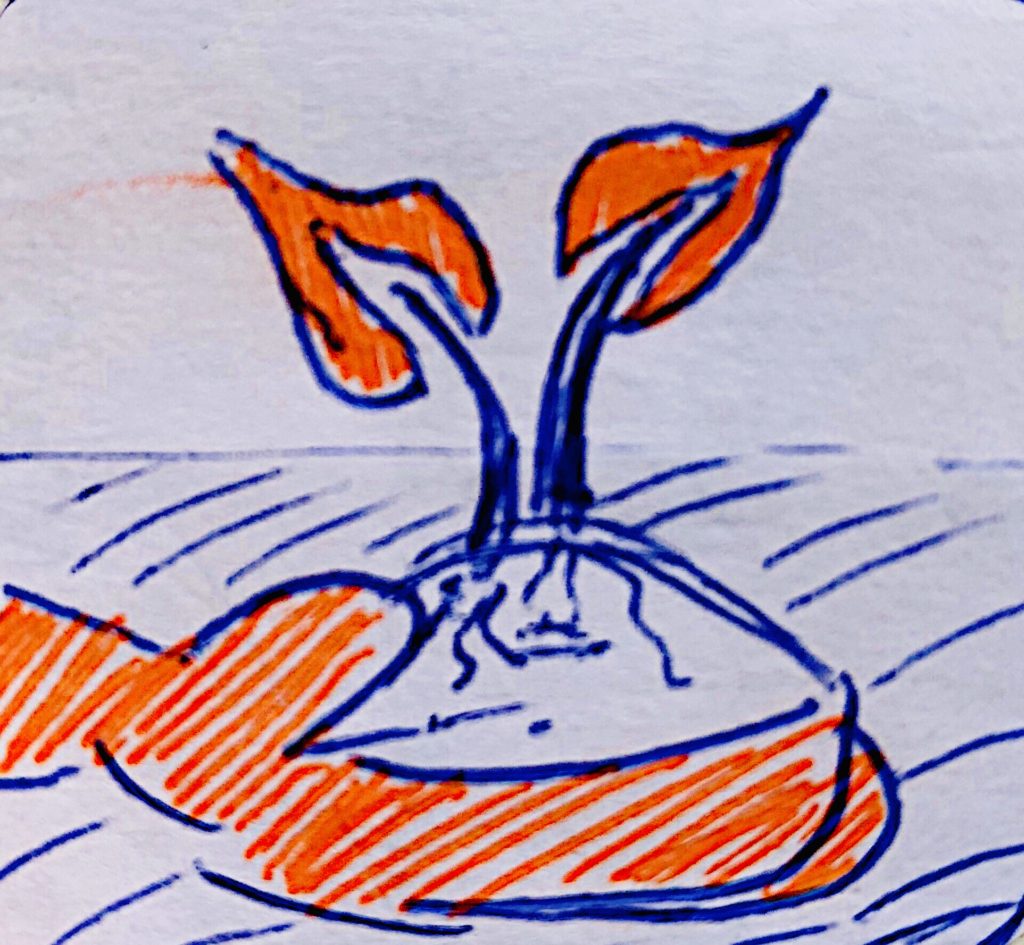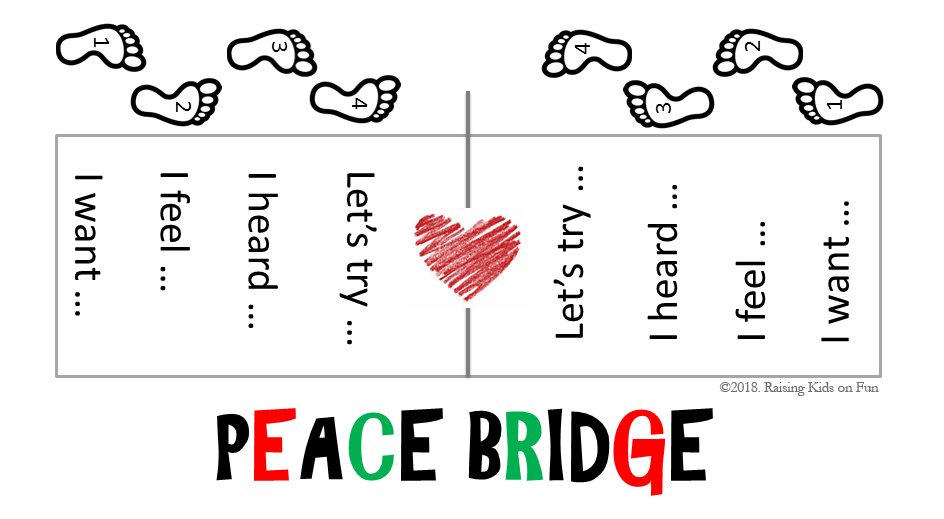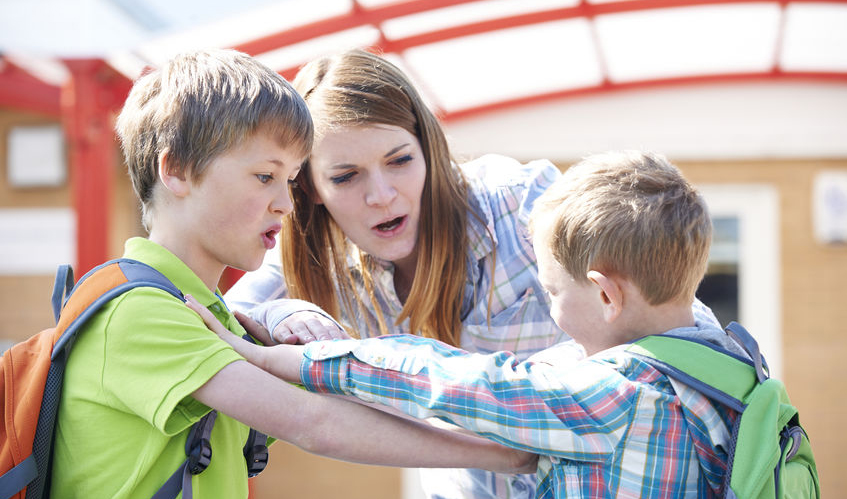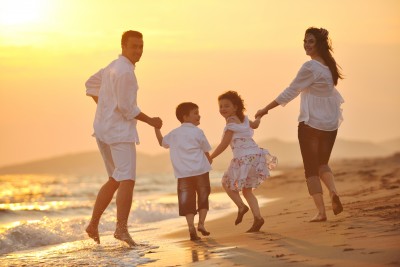I try to wait as long as possible before walking by to give the kids a chance to work things out themselves, but sometimes children lack the skills to resolve conflicts. If I hear shouting, crying and tears that goes beyond a minute or two, I know they need help. If you haven’t read the first article, take a look at that first. I’m still waiting for the day my kids initiate this on their own (ages 7 and 8); but for now, I say “Peace Bridge” and give a hand gesture to signal the kids to start this process. Our family loves to eat great food, but I’ll postpone dinner or even be late to an event if the conflict is big enough because after 1-2 hrs (or even 5-10 minutes for young kids), the teachable moment has disappeared.

I WANT: After both kids have agreed to start Peace Bridge, they stand apart … ideally with labels on the ground (till they get used to this). At this point, kids may be hostile and not in a peacemaking mood. The facilitator can help both to calm down enough. Sometimes just taking a deep breath or counting in reverse from 10 to 1 is enough.
During the “I want” portion, they simply take turns sharing what they want. Clear, concrete words must be used. It’s unacceptable to say “I want her to not be so mean.” It’s not about who’s wrong. No ACCUSATIONS are allowed and both need to LISTEN without defending themselves because whether we agree or not, this IS what the other party wants. After both share what they want, they take a step forward.

I FEEL: Young children can often share what they want but may need some coaching to describe how they feel. The facilitator can help by suggesting a few options and explaining what those words mean. “Do you feel mad? Do you feel sad because he isn’t playing with you? do you feel tired that you keep needing to ask for the same thing again and again? Do you feel frustrated?” The facilitator can help, but it is important for the child to actually say how they’re feeling.
During the “I feel” portion, they simple take turns sharing what they feel. Usually, anger has died down, but it’s still important to keep accusations out of the discussion. After both share what they feel, they take a step forward.

I HEARD: This is my favorite part of Peace Bridge because IT WORKS, and I often see the attitudes shift from hostility to peacemaking after finishing this part. I prompt the kids and say something like, ” what I think I heard you say is _____ ” . Then you need to wait till your child can try to paraphrase what was said. The facilitator asks the other kid, “Do you feel like _____ heard what you said?” If the answer is “yes”, they take a step forward. If the answer is “no”, I ask, “can you explain what’s missing? or “can you share what _____ does not understand?”. Then you repeat with the other child.
If the kids don’t feel understood, I let them keep clarifying until both feel understood. A skilled facilitator can help guide younger kids here. We started this when my kids were 4 and 5 yrs old. In retrospect, it might’ve been better to wait another year. Now at age 6 and 7, Peace Bridge works so much better.
By the time both kids feel “heard”, I usually see smiles and both are eager to go to the next step. Dad is already cheering inside, but I keep a poker face till we’re done.

LET’S TRY:
As a problem solver, I used to always jump to this step first … but the result was that no one listened and everyone got madder. But if the kids have walked through the first few steps, this part comes naturally. I prompt the kids to say, “one thing we might try is ______. ” The facilitator’s job is to challenge the kids to think if their solution is specific enough and if it really addresses the issue. It’s best if the actual solution comes out of the mouth of your kids, but again less mature kids may need help. I ask questions like, “Is this something that you think would help?”.
After each solution is shared, I ask, “so is this something both of you would like to try?” If they say “no”, I guide them to work it out. If they say “yes”, then I would typically repeat the proposed solutions once more and make sure they both understand.
Blessed are the peacemakers, for they will be called children of God.
~Jesus of Nazareth, 1st Century AD
PEACE:
It may seem strange to start a blog about raising kid on fun with a long article on making peace, but you’ll quickly discover that it is impossible to have much fun if there is no peace. Parents can use ultimatums, a loud voice or severe threats of punishment; but the issues and the tensions still exist and fester.
The very last step of Peace Bridge is that both kids must give each other a handshake, a high-five or a hug. I insist on this visible sign of reconciliation even though both are calm and happy because it is a visible sign of reconciliation. It reminds them that they’ve passed over the conflict and can keep moving forward.
We’ve been amazed, but so far 100% of conflicts that we’ve used Peace Bridge with have been successfully resolved, and the best part is that both kids walk away with smiles every time. Peace Bridge is not for every conflict, but you’ll be amazed at how well it works for many of the conflicts in the house.
As a father, I find great JOY when I see my kids playing or working together. I think learning to make peace with each other also make them better people as they venture off in the world. And … yes … you may be amazed that even a little 4 year old can be a peace maker.




Some schools just paint something on the ground, but I love how East View Elementary School in Owensboro, KY actually build something physical and placed it in the school yard to help kids work out conflicts well. https://www.owensbororadio.com/2018/09/10/peace-bridge-helps-kids-resolve-conflicts/